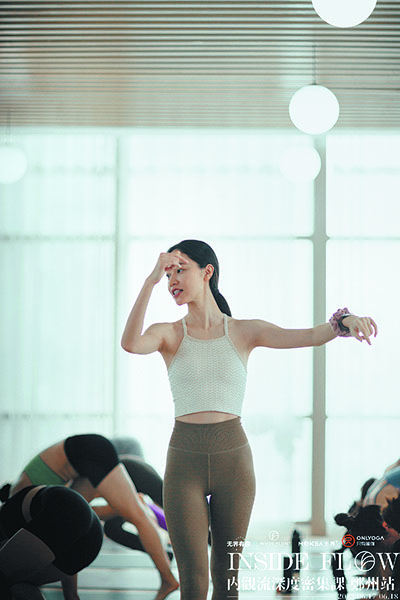

A form of modern yoga called Inside Flow is one popular form, with music, movement and mindfulness among its selling points.
Ge Ruhua, founder of the yoga chain Moksa, said when Moksa held its first annual national training event for Inside Flow in Xiamen, Fujian province, in 2018, only about 40 people turned up. But this year, in August alone, mass Inside Flow training events have been held across the country, as well as in other parts of Asia, attracting thousands to take part.
"The recipe of Inside Flow yoga is unique. It's a mixture of music, yoga movement, breathing and emotions. That's the reason why it's addictive," said its founder Kim Young-ho, a German of Korean descent.
Christine Cheng, a yoga instructor from Taiwan, said: "Rather than being seen as a form of exercise, it is more like an emotional release. Nowadays, people in cities have a fast-paced work life and face a lot of pressure. It's difficult to relieve this pressure in a short period of exercise alone. However, with the inclusion of these elements, each of my students, despite entering the classroom in a variety of states, leaves feeling very happy. Happiness is universal."
"At practice, I'm not someone's mother or wife, I'm just myself. I hope that more people can find this feeling of being themselves, and life will be more meaningful," said the mother of three.
"Life can be hard for us. I sometimes put myself in my students' shoes — when we enter a yoga studio, what are we looking for? The answer is to be relaxed."
She said her yoga students come from all walks of life, from college students and businesspeople to stay-at-home moms and retired seniors.
"I remember a man at the age of nearly 60 achieving his first splits during my class. What's really cool about yoga is that it not only relaxes us, but also allows us to explore more possibilities, to challenge and exceed ourselves," she said.
Li Chunru, 67 and retired in Beijing, said yoga is the most important thing she does in her daily life. She goes to a yoga studio 10 minutes from her home every noon and evening for practice.
"My daughter always says that she wants me to have good health, and recommended yoga as a daily exercise when she left home for university. So I started practicing 6 years ago," she said.
Li's physique belies her age and she said has had a clean bill of health on her annual body check for the past few years.

Despite its growing appeal nationwide, the epicenters of China's yoga movement remain in the mega cities of Shanghai and Beijing, where almost a third of all yoga practitioners in the country are located, according to Dao Insights.
Those taking their places on their yoga mats are relatively well-off, too, with 41 percent of them having monthly incomes in excess of 10,000 yuan.
The growth in the popularity of yoga is by no means limited to China, with increasing numbers of new practitioners popping up across the globe.
From a yoga training summit in Shenzhen in May to another summit in Suzhou in August, like many foreign practitioners, Pan Miaoling from Vietnam has followed yoga events to many cities in China. She said that after exchanging ideas with dedicated instructors in China, she would return to Vietnam with a lot of positive energy and transmit that power in her own classes.
Inside Flow yoga founder Kim has emphasized the harmonious nature of the practice.
"There are always various disputes and competitions in the world, but when young individuals from different countries come together, they genuinely like each other. Just like in every international Inside Flow exchange event, people from different countries share and communicate with each other through music, movements and expressions, and we all enjoy this process."
Kim said that he has done a DNA test and found that he is 25 percent Korean, 25 percent Japanese and 15 percent Chinese. "Although we may not speak the same language, we are all mixed together, and there aren't that many differences. Our feelings and preferences are actually the same, and music and movement are also universal languages."